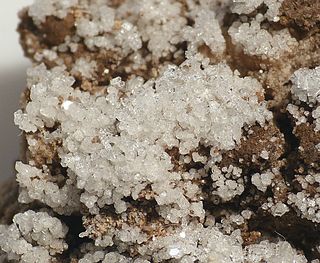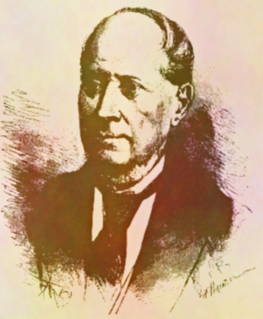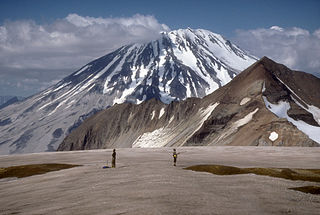
A fumarole is a vent in the surface of the Earth or other rocky planet from which hot gases and vapors are emitted, without any accompanying liquids or solids. Fumaroles are characteristic of the late stages of volcanic activity, but fumarole activity can also precede a volcanic eruption and has been used for volcano prediction. Most fumaroles die down within a few days or weeks of the end of an eruption, but a few are persistent, lasting for decades or longer. An area containing fumaroles is known as a fumarole field.

Vulcano or Vulcan is a small volcanic island belonging to Italy in the Tyrrhenian Sea, about 25 km (16 mi) north of Sicily and located at the southernmost end of the seven Aeolian Islands. The island is 21 km2 (8 sq mi) in area, rises to 501 m (1,644 ft) above sea level, and it contains several volcanic calderas, including one of the four active volcanoes in Italy that are not submarine.

Salammoniac, also sal ammoniac or salmiac, is a rare naturally occurring mineral composed of ammonium chloride, NH4Cl. It forms colorless, white, or yellow-brown crystals in the isometric-hexoctahedral class. It has very poor cleavage and is brittle to conchoidal fracture. It is quite soft, with a Mohs hardness of 1.5 to 2, and it has a low specific gravity of 1.5. It is water-soluble. Sal ammoniac is also the archaic name for the chemical compound ammonium chloride.

Melanterite is a mineral form of hydrous iron(II) sulfate: FeSO4·7H2O. It is the iron analogue of the copper sulfate chalcanthite. It alters to siderotil by loss of water. It is a secondary sulfate mineral which forms from the oxidation of primary sulfide minerals such as pyrite and marcasite in the near-surface environment. It often occurs as a post mine encrustation on old underground mine surfaces. It also occurs in coal and lignite seams exposed to humid air and as a rare sublimate phase around volcanic fumaroles. Associated minerals include pisanite, chalcanthite, epsomite, pickeringite, halotrichite and other sulfate minerals.

Luigi Palmieri was an Italian physicist and meteorologist. He was famous for his scientific studies of the eruptions of Mount Vesuvius, for his researches on earthquakes and meteorological phenomena and for improving the seismograph of the time.

Thenardite is an anhydrous sodium sulfate mineral, Na2SO4 which occurs in arid evaporite environments, specifically lakes and playas. It also occurs in dry caves and old mine workings as an efflorescence and as a crusty sublimate deposit around fumaroles. It occurs in volcanic caves on Mount Etna, Italy. It was first described in 1825 for an occurrence in the Espartinas Saltworks, Ciempozuelos, Madrid, Spain and was named for the French chemist, Louis Jacques Thénard (1777–1826).

Tolbachik is a volcanic complex on the Kamchatka Peninsula in the far east of Russia. It consists of two volcanoes, Plosky (flat) Tolbachik and Ostry (sharp) Tolbachik, which as the names suggest are respectively a flat-topped shield volcano and a peaked stratovolcano. As Ostry is the mountain's highest point, the entire mountain is often referred to as "Ostry Tolbachik", not to be confused with Ostry, a separate volcano to the north also on the Kamchatka Peninsula.

Atacamite is a copper halide mineral: a copper(II) chloride hydroxide with formula Cu2Cl(OH)3. It was first described for deposits in the Atacama Desert of Chile in 1801 by D. de Fallizen. The Atacama Desert is also the namesake of the mineral.

Mount Griggs, formerly known as Knife Peak Volcano, is a stratovolcano, which lies 10 km behind the volcanic arc defined by other Katmai group volcanoes. Although no historic eruptions have been reported from Mount Griggs, vigorously active fumaroles persist in a summit crater and along the upper southwest flank. The fumaroles on the southwest flank are the hottest, and some of the flank fumaroles can roar so loudly that they can be heard from the valley floor. The slopes of Mount Griggs are heavily mantled by fallout from the 1912 eruption of Novarupta volcano. The summit consists of three concentric craters, the lowest and largest of which contains a recent summit cone topped by two craters. The volume of the volcanic edifice is estimated at about 25 cubic kilometers (6.0 cu mi). Isotopic analysis indicates that the source of Griggs' magma is distinct from the other Katmai volcanoes.
Ziesite is a copper vanadate mineral with formula: β-Cu2V2O7. It was discovered in 1980 as monoclinic crystals occurring as volcanic sublimates around fumaroles in the crater of the Izalco Volcano, El Salvador. It is named after Emanuel George Zies (1883–1981), an American geochemist who studied Izalco in the 1930s.

Volcán Putana, sometimes referred to as Jorqencal or Machuca, is a stratovolcano located In the Central Volcanic Zone (CVZ) of the Andes on the border between Bolivia and Chile and close to the Sairecabur volcanic complex. Its summit is 5,884 metres (19,304 ft) above sea level and contains a summit crater with two smaller craters nested within it. Beneath the summit, the volcano features a number of lava domes and lava flows, some of which originated in flank vents.
Lyonsite (Cu3Fe+34(VO4)6) is a rare black vanadate mineral that is opaque with a metallic lustre. It crystallizes in the orthorhombic crystal system. Lyonsite often occurs as small tabular typically well formed crystals. Lyonsite has a good cleavage and a dark gray streak.
Colimaite, the naturally occurring analog of synthetic K3VS4, is a sulfide mineral discovered in southwestern Mexico. The potassium-vanadium sulfide was collected from the crater of the Colima volcano. The mineral colimaite is named after the locality of this volcano and has been approved in 2007, along with its mineral name, by the Commission on New Minerals, Nomenclature and Classification (CNMNC). It has been given the International Mineralogical Association number of IMA 2007–045.

Avogadrite ((K,Cs)BF4) is a potassium-caesium tetrafluoroborate in the halide class. Avogadrite crystallizes in the orthorhombic system (space group Pnma) with cell parameters a 8.66 Å, b 5.48 Å and c Å 7.03.

Ceboruco is a dacitic stratovolcano located in Nayarit, Mexico, northwest of the Trans-Mexican Volcanic Belt. The largest eruption, the Jala Plinian eruption, was around 930 AD ±200, VEI 6, releasing 11 cubic kilometres (2.6 cu mi) of tephra. The most recent and best documented eruption from Ceboruco lasted from 1870–1875, with fumarole activity lasting well into the 20th century. The mountain features one large caldera, created during the Jala eruption, with a smaller crater nested inside that formed when the Dos Equis lava dome collapsed during the Coapales eruption around 1100 AD. Within both of these craters, are several explosive volcanic features, including scoria deposits, lava domes, and pyroclastic domes, or cinder cone volcanoes.
Fingerite is a copper vanadate mineral with formula: β-Cu2V2O5. It was discovered as triclinic crystals occurring as volcanic sublimates around fumaroles in the crater of the Izalco Volcano, El Salvador.
Wulffite is an alkali copper sulfate mineral with the chemical formula K3NaCu4O2(SO4)4, in the sulfate category of minerals. It was recently discovered in Kamchatka, Russia at the Tolbachik volcano in 2012. It was named for Russian crystallographer Georgiy Viktorovich Wulff, a renowned expert who furthered X-ray diffraction and interference. Wullfite shares many properties with parawulffite, which was found in the same area just with slightly different chemical composition.
Euchlorine (KNaCu3(SO4)3O) is a rare emerald-green colored sulfate mineral found naturally occurring as a sublimate in fumaroles around volcanic eruptions. It was first discovered in fumaroles of the 1868 eruption at Mount Vesuvius in Campania, Italy by Arcangelo Scacchi. The name 'euchlorine' comes from the Greek word εΰχλωρος meaning "pale green" in reference to the mineral's color, other reported spellings include euclorina, euchlorin, and euchlorite.

Fumarole minerals are minerals which are deposited by fumarole exhalations. They form when gases and compounds desublimate or precipitate out of condensates, forming mineral deposits. They are mostly associated with volcanoes, but have been encountered on burning coal deposits as well. They can be black or multicoloured and are often unstable upon exposure to the atmosphere.

Guallatiri is a 6,071-metre (19,918 ft) high volcano in Chile. It is located southwest of the Nevados de Quimsachata volcanic group and is sometimes considered to be part of that group. It is a stratovolcano with numerous fumaroles around the summit. The summit may be composed of either a lava dome or a pyroclastic cone, while the lower flanks of the volcano are covered by lava flows and lava domes. The volcano's eruptions have produced mostly dacite along with andesite and rhyolite.













